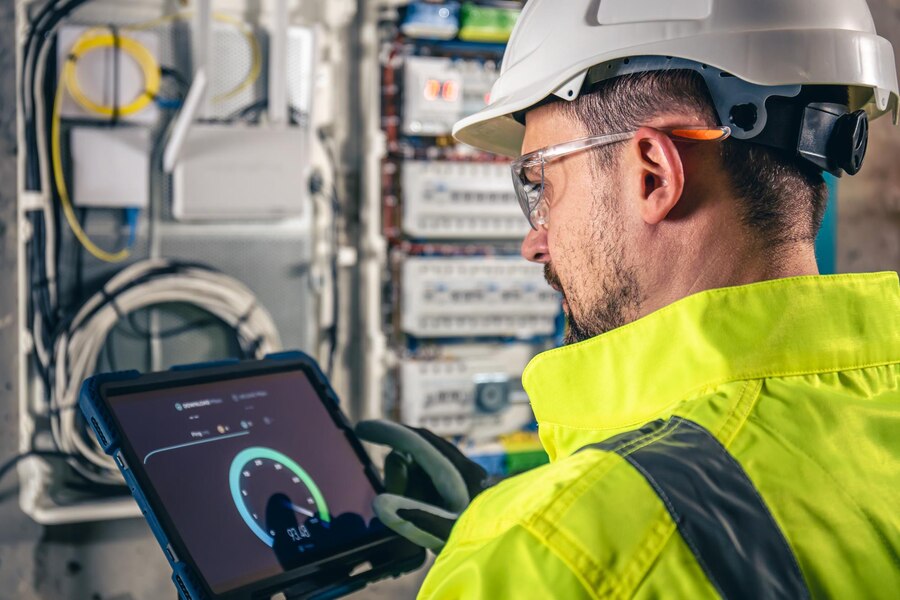Arc Flash Analysis: Mitigating Electrical Risks
4 Mins Read
Published on: 20 January 2024
Last Updated on: 05 June 2025

Within electrical safety, arc flash is a highly significant occurrence demanding urgent focus. Sudden energy discharge fuels these striking spectacles marked by vivid light and searing thermal radiation. Possible fallouts feature deadly injuries, equipment destruction, and worse, human casualties.
Evaluating arc flash danger is critical for managing electrical risks. Thorough inspection of circuits detects potential hazards and suggests preventive steps. Installing advanced tech, like flame-resistant devices and improved protocols, lowers the probability and severity of arc flash events, ensuring employee safety and circuitry stability.
Understanding Arc Flash Analysis
An arc flash hazard assessment is a critical process that helps to predict the potential for arc flash incidents within a given electrical environment. This analysis, conducted by qualified electrical safety professionals, is guided by established standards such as NFPA 70E and IEEE 1584. These standards provide a comprehensive framework for executing a detailed assessment and implementing preventive strategies.
The primary goal of an arc flash analysis is to identify and quantify arc flash hazards. It calculates the incident energy workers could be exposed to during an arc flash event. Based on these findings, safety measures are recommended, including using appropriate Personal Protective Equipment (PPE), developing safety procedures, and marking warning labels on electrical equipment.
To help you better understand this complex yet essential process, here’s a breakdown of its key aspects:
- Data Collection: This initial step entails diligently collecting all pertinent electrical documentation, including comprehensive system layouts, meticulous equipment specifications, precise protection settings, and other essential details crucial for the successful execution of the project.
- System Modeling: The collected data, consisting of various electrical parameters and measurements, is meticulously processed to create a comprehensive and precise electrical system model. This detailed model serves as the foundation for conducting in-depth analysis and evaluation, enabling engineers and researchers to gain valuable insights into the behavior and performance of the system.
- Fault Analysis: Sophisticated mathematical models and advanced software tools are meticulously employed to identify potential fault points within intricate systems. These cutting-edge tools are also utilized to precisely calculate the incident energy levels present at these specific locations, ensuring utmost accuracy and precision in fault analysis and mitigation.
- Identifying Potential Hazards: The worst-case arc flash energy levels, which pose significant risks in electrical systems, are determined by carefully analyzing and solving multiple scenarios. This comprehensive evaluation takes into account various operating conditions, such as voltage levels, equipment configurations, and environmental factors. By considering these intricate details, engineers can effectively mitigate potential hazards and ensure the safety of personnel working with electrical equipment.
- Safety Measures Recommendation: Post identification of high-risk regions, adequate precautionary steps are suggested. Design adjustments, modifying protective configurations, or applying specialized safety garb (like PPE) form part of typical suggestions.
- Labeling: The results of the arc flash analysis are used to create warning labels that indicate the level of hazard and the required safety equipment.
The Process Of Arc Flash Analysis
The first step in an arc flash analysis is to gather all existing electrical documentation of the facility. This includes drawings, system layouts, equipment specifications, and protection settings. With this information at hand, an accurate model of the electrical system can be created for further analysis.
Next, the system is analyzed to identify potential fault points and to calculate the incident energy levels at these locations. This involves complex mathematical models and software tools designed for this purpose. The worst-case arc flash energy levels are determined by solving multiple scenarios, considering different operating conditions and configurations.
Upon identifying the areas with potential arc flash hazards, appropriate safety measures are recommended. These include system design changes, modification of protection settings, and using PPE. Analysis outcome identifies hazard categories and PPE needs, forming a base for marking warnings accordingly.
The Role Of Arc Flash Analysis In Mitigating Electrical Risks
Performing arc flash analysis is vital for controlling electrical dangers, spotting potential pitfalls, and proposing defensive measures. Apart from guarding workers against harsh injuries, it secures the plant’s smooth functioning and saves time, resources, and repair costs.
Undertaking periodic arc flash reviews is essential since tweaks in the electrical framework can modify incident energy ratings. Experts suggest updating this analysis every five years or immediately once significant changes emerge in the system.
Arc Flash Analysis: The Cornerstone Of Electrical Safety
Ultimately, arc flash analysis is an invaluable instrument in electrical safety. Unlocking insights into hidden dangers empowers decisive protective strategies. Dependence on electrical supply intensifies, magnifying the importance of regular analysis.
Acting preemptively guards workers and industrial continuity. Mindset shift: proactivity triumphs reactivity in electrical safety. Always prioritize prevention over reaction. Thanks so much for reading.
Read Also



















Comments Are Closed For This Article